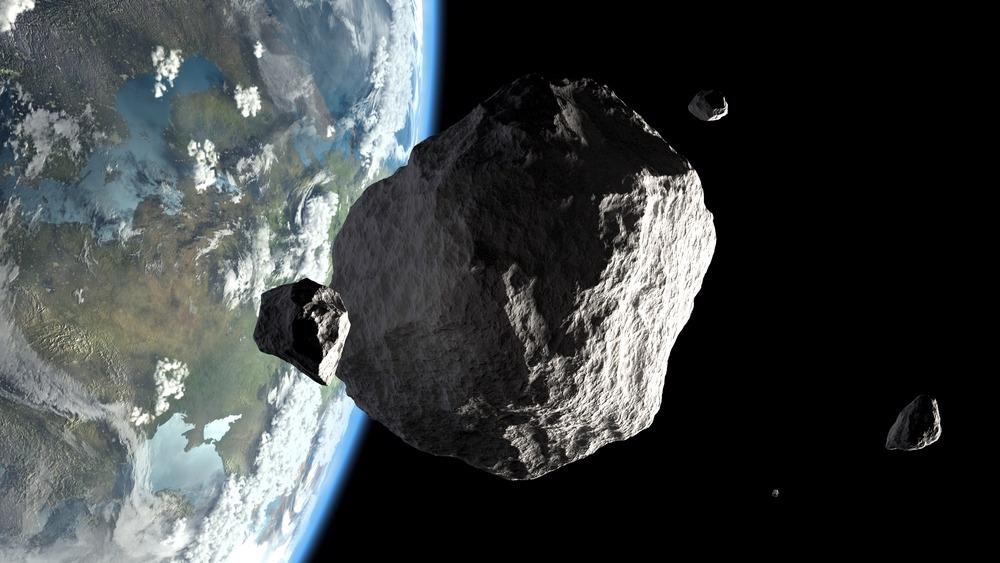In a recent study posted to the Research Square preprint* server as a submission to the journal Nature, researchers from Japan studied the unique and pristine record of materials from asteroid Ryugu.

Study: Hayabusa2 returned samples: A unique and pristine record of outer Solar System materials from asteroid Ryugu. Image Credit: Alexyz3d/Shutterstock.com
Ryugu Asteroid
C-type (carbonaceous) asteroids were developed in the outer solar system and then scattered inwards during the giant planet migration. It was assumed that they transferred volatiles to the inner solar system, which allowed life to grow on Earth.
Additionally, carbonaceous chondrites, which are part of C-type asteroids, prove that C-type asteroids were subjected to extensive aqueous alteration during the early solar system’s history. On December 6, 2020, the Hayabusa2 spacecraft delivered 5.4 kg of C-type asteroid Ryugu to Earth.
The results of an integrated micro-analytical and bulk study of Ryugu particles are presented in the current paper. They provide a unique insight into relationships of surrounding hydrous minerals and aliphatic-rich organics of the C-type asteroids. Additionally, the research data obtained from the study is significant for understanding organic matter’s origins and early evolution in the solar system. Furthermore, it shows that Ryugu particles are the least contaminated extraterrestrial materials ever studied by humanity.
Transportation, Preservation, and Testing of Ryugu Asteroid Samples
To discover the Ryugu asteroid, the Hayabusa2 spacecraft of the Japan Aerospace Exploration Agency (JAXA) conducted extensive remote sensing investigations between June 2018 and November 2019. After discovering Ryugu, the Hayabusa2 spacecraft landed twice on the asteroid and collected surface material samples.
Chamber A of the spacecraft collected the samples from the Ryugu asteroid’s surface and chamber C collected the material near an artificial crater developed by a small carry-on impactor; finally, all the materials were stored in the chamber C. The research team received 60 mg of Ryugu particles.
As soon as the spacecraft landed on Earth, the Ryugu asteroid fragments were recovered from the Hayabusa2 capsule and transported to the JAXA Curation Facility in Sagamihara, Japan. It was ensured that the samples were not contaminated by the terrestrial atmosphere during transportation.
An airtight sample transport vessel and a sample capsule pack were used to avoid chemical reactions with the surrounding environment and terrestrial contaminants such as water vapor, atmospheric gases, hydrocarbons, and small particles. Additionally, cross-contamination between samples was prevented during sample preparation and transportation after initial and non-destructive characterizations at the JAXA Curation Facility.
The samples were named based on the chamber they were found in and their weight. The samples from chamber A were given notations such as A0029 and A0037, and those from chamber C were given notations such as C0009 and C0014.
More from AZoM: Producing Polymers from Waste Sulfur
The researchers used detailed isotopic, elemental, and mineralogical characterization of Ryugu particles to interpret Ryugu’s surface material properties. The Ryugu particles were analyzed using energy-dispersive X-ray spectroscopy, electron probe microanalysis, focused ion beam processing, instrumental neutron activation analysis, scanning electron microscopy, and transmission electron microscopy. The spatial distribution investigation of organic carbon across the entire surface area of the Ryugu particle was performed using coordinated microanalysis techniques.
Results
A detailed mineralogical analysis of A0037, A0029, C0014, C0009, and C0068 revealed mainly coarse-grained, fine, and phyllosilicates. X-ray diffraction patterns of samples showed mineral inventories similar to those found in Orgueil meteorites samples but distinct from Mighei-type chondrites.
Ryugu particle bulk elemental analysis was also similar to those of carbonaceous (Cl) chondrites. C chamber particles’ average composition was similar to Orgueil’s meteorite samples but differed from Y-82162 (Yamato-82162 asteroid) samples.
Individual analyses for A0098 and C0068 demonstrated a lighter isotopic composition than the average chamber C samples, but overall isotopic heterogeneity was observed in the samples.
Carbon near-edge X-ray absorption fine structure (NEXAFS) spectra of the Ryugu particle section demonstrated the presence of a variety of functional groups that included aromatic groups such as C=O (286.5 eV), C=C (285.2 eV), and C(=O)O (288.8 eV), and aliphatic (287.5 eV).
The heterogeneous distribution of organics in the Ryugu particles was similar to the Murchison meteorite. Similarly, the Nanoglobules discovered in Tagish Lake were made up of oxidized organic matter, disordered polycyclic aromatic organic matter, and more complex organic structures that are comparable to Ryugu particles.
Compared to other solar system objects, bulk mineralogy analysis conducted by X-ray powder diffraction (XRD) of the A0002, A0037, and C0068 sections shows no apparent correlation between Ryugu sections. However, the A0002, A0037, and C0068 sections are consistent with those found in comet samples.
Conclusions
The study concluded that the CI meteorites are terrestrially the least contaminated samples, and they provide the first direct evidence of an interaction between aliphatic-rich organics and adjacent hydrous minerals.
*Important Notice
Research Square publishes preliminary scientific reports that are not peer-reviewed and, therefore, should not be regarded as conclusive, guide clinical practice/health-related behavior, or treated as established information.
Disclaimer: The views expressed here are those of the author expressed in their private capacity and do not necessarily represent the views of AZoM.com Limited T/A AZoNetwork the owner and operator of this website. This disclaimer forms part of the Terms and conditions of use of this website.
Source:
Ito, M., Tomioka, N., Uesugi, M., Yamaguchi, A., Shirai, N., Ohigashi, T., Liu, M.C., Greenwood, R., Kimura, M., Imae, N., and Uesugi, K., 2022. Hayabusa2 returned samples: A unique and pristine record of outer Solar System materials from asteroid Ryugu. https://www.researchsquare.com/article/rs-1270941/v1